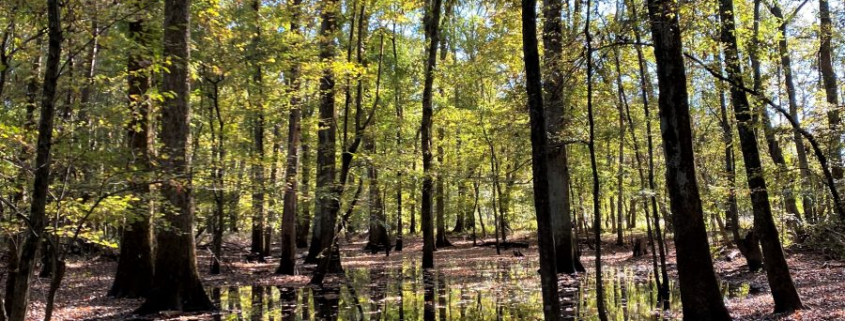Early November 2021 B-Roll at the Goldsmith-Schiffman Wildlife Sanctuary
Perfect Autumn Afternoon for Videography
In Meadows
November 2, 2021, retired videographer Bill Heslip and I spent a picture-perfect fall afternoon capturing B-Roll video at Huntsville, Alabama’s Goldsmith-Schiffman Wildlife Sanctuary for our 17-20-minute video (Summer 2022 release) communicating the land legacy tale for this magnificent natural preserve. The purpose of this Post is to provide an update on the video project I introduced in late August: https://stevejonesgbh.com/2021/08/25/contemplating-a-video-of-the-goldsmith-schiffman-wildlife-sanctuary/
The Sanctuary is rich with ecotones, an ecology term indicating the transition zone between adjoining ecosystems, in both cases below meadow meets forest edge. The mix favors greater diversity of all life, including plants and animals. Toss in the nearby Flint River and the ridge several miles to the west rising 800 feet above the valley floor; the result is a ridge/valley/riverine ecosystem that warrants recognition, preservation, and celebration.
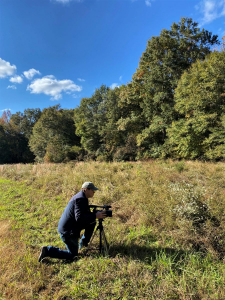
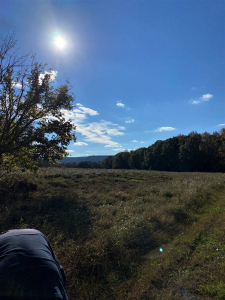
My role during our outing was to assist Bill by pointing out ecological features and their significance…and stay out of the viewfinder! I enjoyed watching Bill at work…and snapping still photos to chronicle our efforts and capture images of the Sanctuary’s magic and wonder.
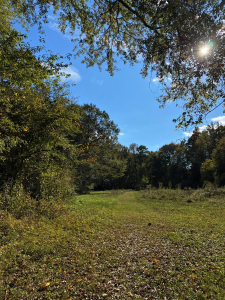
I’ve often thought when visiting the Sanctuary about the tremendous gift that Magaret Anne Goldsmith passed along to many future generations of Huntsville citizens. One objective of our video project is to make sure viewers understand and appreciate that value.
In Forests
Although I appreciate the diverse habitats and ecotones, this old forester’s heart beats a little faster in the Sanctuary’s forests. Still a week shy of maximum fall color, yellows tinted the canopy and gradual leaf-fall allowed increasing levels of sunlight to brighten the forest floor. Oak, sweetgum, hickories, poplar, and other species populate these riparian stands often flooded by the Flint River.
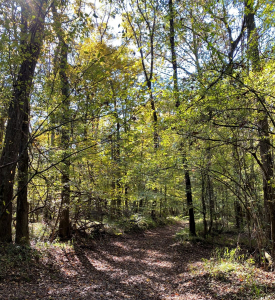
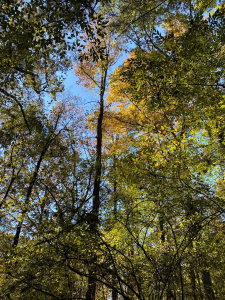
Peace and Tranquility Amidst Fierce Competition
Cerulean skies add emphasis to the fall canopy. I’ve written often in these Posts that trees battle fiercely for finite sunlight. Popular literature, including some pseudo-scientific writing would have us believe that our forests are utopian Gardens of Eden, where all is tranquil, peaceful, loving, cooperative, communal, and interlaced in the spirit of one big happy ecosystem. Sure, ecosystems do, in fact, operate as interwoven systems, yet each species looks out first and foremost for number one.
John Muir, a consumate student of Nature, observed:
I have never yet happened upon a trace of evidence… to show that any one animal was ever made for another as much as it was made for itself.
My view is that the same holds true for all living organisms: plants, animals, fungi, microbes. Cooperation, symbiosis, commensualism, and other such relationships flourish only to the extent that what benefits others is embraced only to the degree that such interactions benefit the individual.
The trees below are engaged in, if necessary, a battle to the death! Only to us enjoying a fall stroll through the forest is all tranquil, peaceful, loving, cooperative, communal, and interlaced in the spirit of one big happy ecosystem. Even the fawn at pace with the doe is a potential meal for a hungry coyote. A mouse to the owl. A squirrel to the hawk. An insect to the jay or dragon fly. The list goes on; the cycle endures.
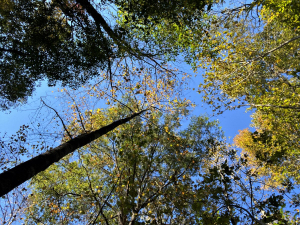
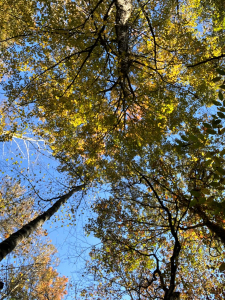
Bill pauses below to record footage of the results of such competition…dead and down woody debris which is common across these maturing forests.
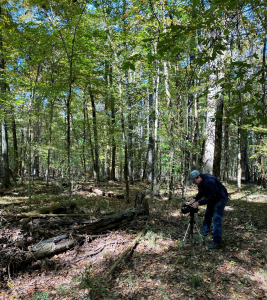
We found this fall equivalent of a vernal pond. I suppose we can term it an autumnal pond. I had measured a little over five inches of rain in in both September and October, ten inches total. No surprise that depressions would be waterlogged. These are oak species not normally restricted to saturated sites. We appreciated the play of color, light, and reflections.
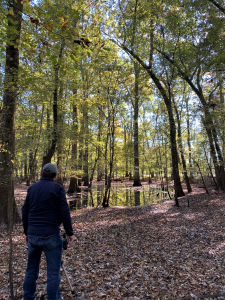
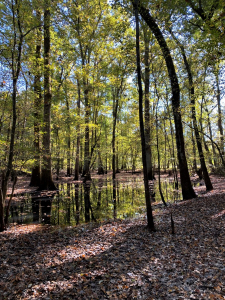
Bill saw special attraction in the tangle of grape vines, a common sight within the riparian forest. Most casual forest observers picture these vines growing up into the trees. Few people are aware that these woody vines grow up with the trees. Vine seedlings begin their life with the tree seedlings, accompanying the ash, oaks, sweetgum, and other tree species during the trees’ vertical growth, keeping their own vine-crowns in the ascending tree canopy. Vine and tree are the same age.
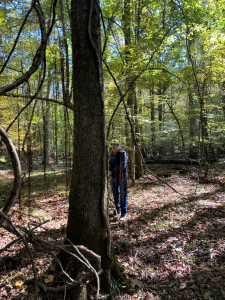
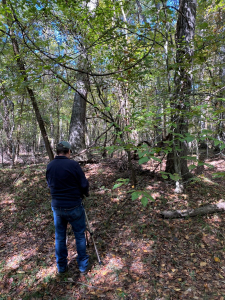
Along the Tupelo Swamp
We ventured to the edge of the Sanctuary’s tupelo forest. Unlike the oak-populated autumnal pond, these are perennial wetlands. Water tupelo demands such saturated sites. Bill and I want the video to present the full range of ecosystems, ecotones, and habitat types. Contrast the following four photos to meadow and deep forest. The three habitats could not be more different. We’ll also cover the west-side spring, the naturalized Jobala Pond, and the Flint River banks. I am not sure whether the Grand Designer could squeeze more diversity into 400 acres!
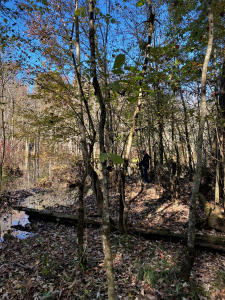
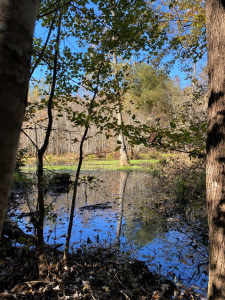
Here we are at the edge of wildness…in Huntsville, Alabama, which within the next decade will be the state’s largest (population) metropolitan area.
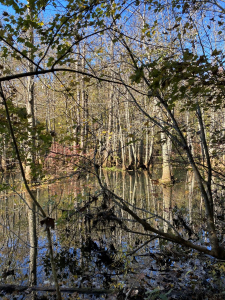
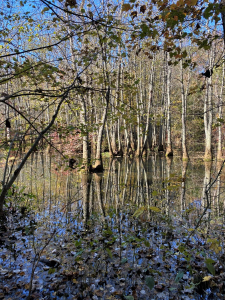
The edge of wildness…perhaps instead within wildness itself. We want the video to celebrate the Sanctuary!
Fungi and Forest Curiosities
The designation wildlife sanctuary implies animals, the life-kingdom to which we humans belong, along with birds, reptiles, amphibians, fish, and mammals. Don’t forget insects, arachnids, mites, slugs, crustaceans, and diverse manner of animal life. The Sanctuary includes ubiquitous and varied plant life, the second kingdom. I grew into my forestry profession learning that fungi were part of the plant kingdom. About the same time the university conferred my bachelors degree, the scientists who controlled life classification decisions elevated fungi to its own kingdom. I admit to being all-consumed by completing finals on Friday, driving the 550 miles Saturday from Syracuse, NY to Franklin, VA, moving into our apartment Sunday, and beginning my first professional assignment Monday. Too consumed with beginning career life to participate in my own graduation or take notice of any society-wide celebration of global fungi rising to their higher order life-classification.
Fungi play a major role in the Sanctuary’s endless cycle of life and death. Both mushrooms below are fruiting bodies (reproductive spore producers) for wood decay fungi. Oak bracket (left) and a species of genus Trichaptum (right).
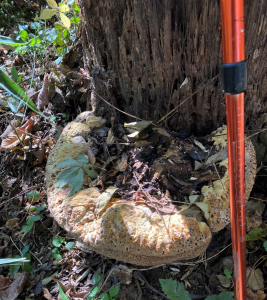
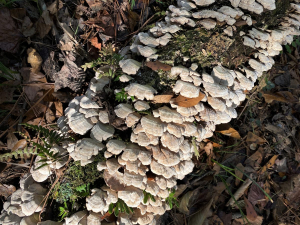
I snapped the conk (mushroom) below two weeks earlier (November 16) at the Sanctuary. Growing from the trunk of a diseased American beech, this appears to be a species of Ganaderma, formerly Fomes applanatus (artist conk). The skilled hand with stylus can etch intricate designs into this polypore’s undersurface.
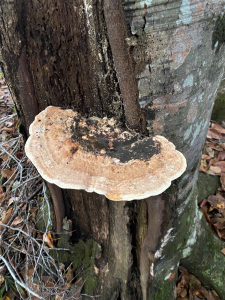
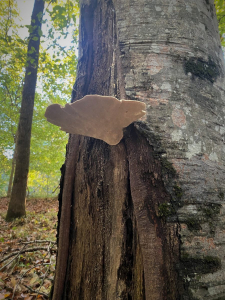
An artist’s conk image from the internet.
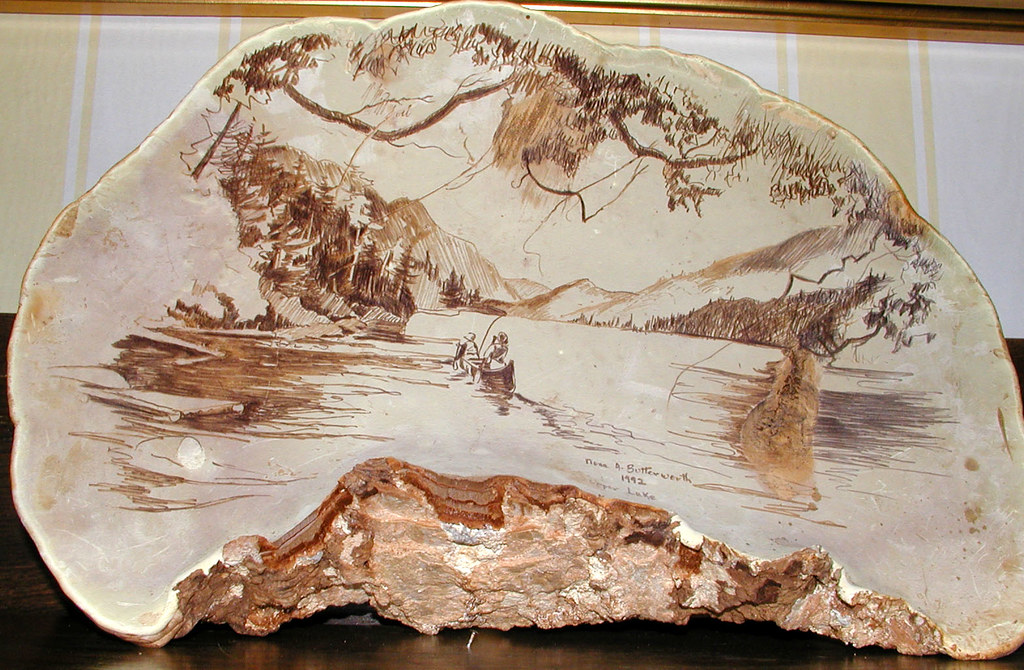
Internet Image
These osage orange fruits (hedge apples) also presented themselves October 16.
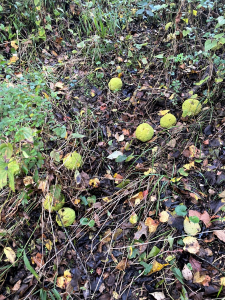
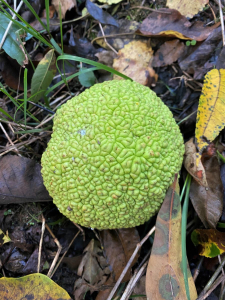
This circumferential red oak burl is just one of the many tree form oddities and curiosities I’ve documented on the Sanctuary. During our four years living in and exploring Alaska, Judy and I often commented that everywhere we looked, we encountered a Kodak moment, a vista meriting photo-capture. Today, as I wander our southern forests, I find photo-worthy subjects around every corner…and give constant thanks for digital technology!
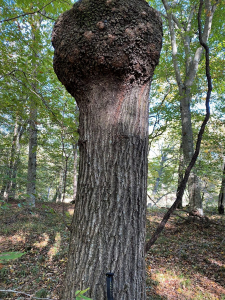
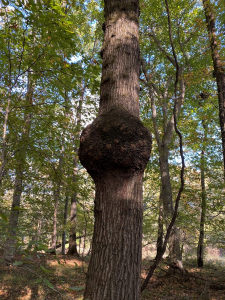
I wonder whether we can distill the Sanctuary’s beauty, magic, wonder, and awe to 17-20 minutes!
Thoughts and Reflections
I offer these observations:
- Nature’s richness knows no bounds.
- The Sanctuary packs untold gifts, surprises, and diversity into a mere 400 acres.
- The value of wildness expands exponentially with its proximity to population centers.
Inhale and absorb Nature’s elixir. May Nature Inspire, Inform, and Reward you!
Note: All blog post images created & photographed by Stephen B. Jones unless otherwise noted. Please circulate images with photo credit: “©2022 Steve Jones, Great Blue Heron LLC. All Rights Reserved.”
Another Note: If you came to this post via a Facebook posting or by an another route, please sign up now (no cost… no obligation) to receive my Blog Post email alerts: http://eepurl.com/cKLJdL
And a Third: I am available for Nature-Inspired Speaking, Writing, and Consulting — contact me at steve.jones.0524@gmail.com
Reminder of my Personal and Professional Purpose, Passion, and Cause
If only more of us viewed our precious environment through the filters I employ. If only my mission and vision could be multiplied untold orders of magnitude:
Mission: Employ writing and speaking to educate, inspire, and enable readers and listeners to understand, appreciate, and enjoy Nature… and accept and practice Earth Stewardship.
Vision:
- People of all ages will pay greater attention to and engage more regularly with Nature… and will accept and practice informed and responsible Earth Stewardship.
- They will see their relationship to our natural world with new eyes… and will understand more clearly their Earth home.
Tagline/Motto: Steve (Great Blue Heron) encourages and seeks a better tomorrow through Nature-Inspired Living!
Steve’s Three Books
I wrote my books Nature Based Leadership (2016), Nature-Inspired Learning and Leading (2017), and Weaned Seals and Snowy Summits: Stories of Passion for Place and Everyday Nature (2019; co-authored with Dr. Jennifer Wilhoit) to encourage all citizens to recognize and appreciate that every lesson for living, learning, serving, and leading is either written indelibly in or is powerfully inspired by Nature.
I began writing books and Posts for several reasons:
- I love hiking and exploring in Nature
- I see images I want to (and do) capture with my trusty iPhone camera
- I enjoy explaining those images — an educator at heart
- I don’t play golf!
- I actually do love writing — it’s the hobby I never needed when my career consumed me
- Judy suggested my writing is in large measure my legacy to our two kids, our five grand kids, and all the unborn generations beyond
- And finally, perhaps my books and Blogs could reach beyond family and touch a few other lives… sow some seeds for the future


All three of my books (Nature Based Leadership; Nature-Inspired Learning and Leading; Weaned Seals and Snowy Summits) present compilations of personal experiences expressing my (and co-author Dr. Wilhoit for Weaned Seals and Snowy Summits) deep passion for Nature. All three books offer observations and reflections on my relationship to the natural world… and the broader implications for society. Order any and all from your local indie bookstore, or find them on IndieBound or other online sources such as Amazon and LifeRich.

